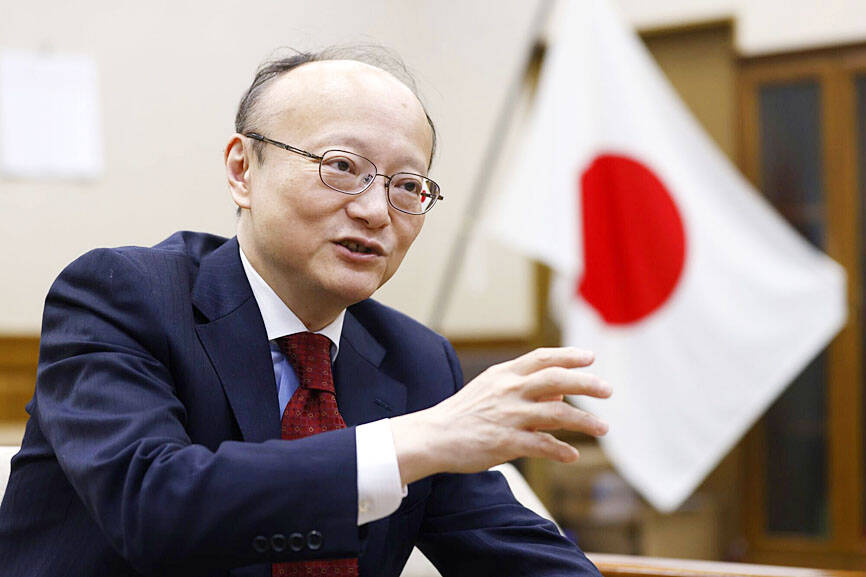Japan’s top currency official said that recent yen weakness is odd and out of line with current economic fundamentals, reaffirming his commitment to act if needed to prevent excessive swings in the exchange rate.
“I strongly feel the recent sharp depreciation of the yen is unusual, given fundamentals such as the inflation trend and outlook, as well as the direction of monetary policy and yields in Japan and the US,” Japanese Vice Minister for International Affairs Masato Kanda said in an interview yesterday. “Many people think the yen is now moving in the opposite direction of where it should be going.”
Kanda’s remarks come amid intense market scrutiny over whether the government would step into the currency market to stem recent falls in the yen, following the Bank of Japan’s decision last week to raise interest rates for the first time since 2007. The currency slid to a 34-year low of ¥151.97 per US dollar on Wednesday, prompting Japanese Minister of Finance Shunichi Suzuki to increase verbal warnings, strongly hinting that Japan could intervene.

Photo: Bloomberg
Finance authorities also convened a three-way meeting, a gathering often used to show heightened concern among policymakers over market movements.
“We are currently monitoring developments in the foreign exchange market with a high sense of urgency,” Kanda said. “We will take appropriate measures against excessive foreign exchange moves without ruling out any options.”
Kanda reiterated the view that Japan is not guarding specific exchange rate levels, but is looking at the direction and speed of movements when assessing developments in the currency market, echoing Suzuki’s comments.
Japan had no defense line on exchange rates, Suzuki said when asked whether the ¥152 mark against the US dollar was a line in the sand.
Tokyo’s biggest intervention splurge was in 2022, after the yen approached 152, though the slide in that direction was much more rapid than currently seen.
Market participants try to gauge the proximity to possible market intervention from the language used by authorities.
“I am just saying what I think is right at the time,” Kanda said, referring to his choice of words.
Behind the yen’s weakness is the view among market players that the difference in policy rate and yields between Japan and its peers, including the US, would remain wide for some time.
Bank of Japan Governor Kazuo Ueda pledged to maintain an accommodative environment when the bank decided to raise its benchmark interest rate last week — ending the world’s last negative rate — pouring cold water on expectations that the bank would soon consider a second hike.
He favors a gradual process toward normalization, but keeping policy easy is not inconsistent with another rate hike, Bank of Japan board member Naoki Tamura said.
The Bank of Japan’s decision was a milestone that showed a virtuous price-wage cycle was in place, with sustainable inflation in sight, Kanda said, adding that strong wage gains during this year’s annual wage negotiations and record spending by companies were positive signs for Japan’s economy.
“Finally we are in an economic situation that enables the Bank of Japan to begin normalization,” Kanda said. “We have come a long way.”

CHIP RACE: Three years of overbroad export controls drove foreign competitors to pursue their own AI chips, and ‘cost US taxpayers billions of dollars,’ Nvidia said China has figured out the US strategy for allowing it to buy Nvidia Corp’s H200s and is rejecting the artificial intelligence (AI) chip in favor of domestically developed semiconductors, White House AI adviser David Sacks said, citing news reports. US President Donald Trump on Monday said that he would allow shipments of Nvidia’s H200 chips to China, part of an administration effort backed by Sacks to challenge Chinese tech champions such as Huawei Technologies Co (華為) by bringing US competition to their home market. On Friday, Sacks signaled that he was uncertain about whether that approach would work. “They’re rejecting our chips,” Sacks

NATIONAL SECURITY: Intel’s testing of ACM tools despite US government control ‘highlights egregious gaps in US technology protection policies,’ a former official said Chipmaker Intel Corp has tested chipmaking tools this year from a toolmaker with deep roots in China and two overseas units that were targeted by US sanctions, according to two sources with direct knowledge of the matter. Intel, which fended off calls for its CEO’s resignation from US President Donald Trump in August over his alleged ties to China, got the tools from ACM Research Inc, a Fremont, California-based producer of chipmaking equipment. Two of ACM’s units, based in Shanghai and South Korea, were among a number of firms barred last year from receiving US technology over claims they have

It is challenging to build infrastructure in much of Europe. Constrained budgets and polarized politics tend to undermine long-term projects, forcing officials to react to emergencies rather than plan for the future. Not in Austria. Today, the country is to officially open its Koralmbahn tunnel, the 5.9 billion euro (US$6.9 billion) centerpiece of a groundbreaking new railway that will eventually run from Poland’s Baltic coast to the Adriatic Sea, transforming travel within Austria and positioning the Alpine nation at the forefront of logistics in Europe. “It is Austria’s biggest socio-economic experiment in over a century,” said Eric Kirschner, an economist at Graz-based Joanneum

OPTION: Uber said it could provide higher pay for batch trips, if incentives for batching is not removed entirely, as the latter would force it to pass on the costs to consumers Uber Technologies Inc yesterday warned that proposed restrictions on batching orders and minimum wages could prompt a NT$20 delivery fee increase in Taiwan, as lower efficiency would drive up costs. Uber CEO Dara Khosrowshahi made the remarks yesterday during his visit to Taiwan. He is on a multileg trip to the region, which includes stops in South Korea and Japan. His visit coincided the release last month of the Ministry of Labor’s draft bill on the delivery sector, which aims to safeguard delivery workers’ rights and improve their welfare. The ministry set the minimum pay for local food delivery drivers at